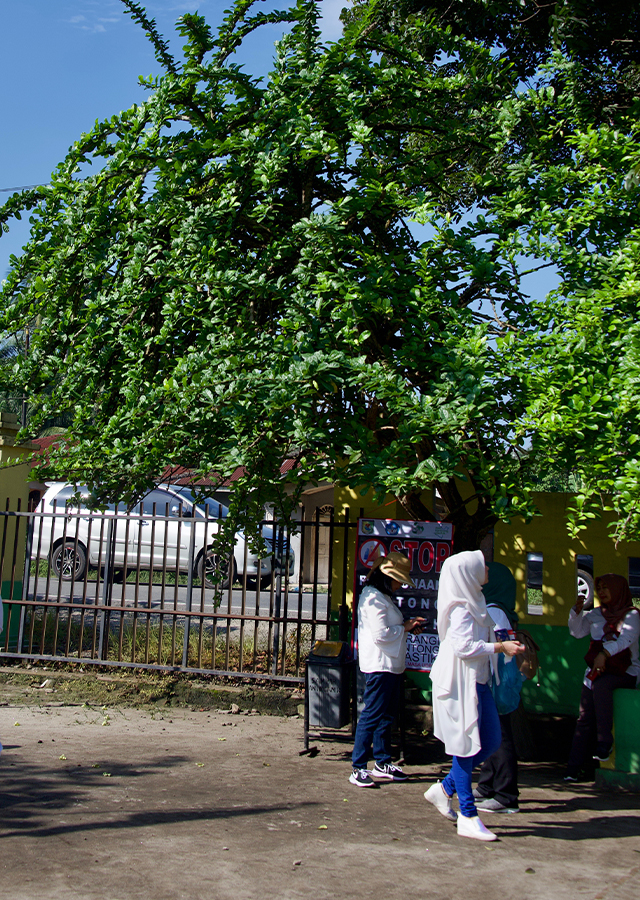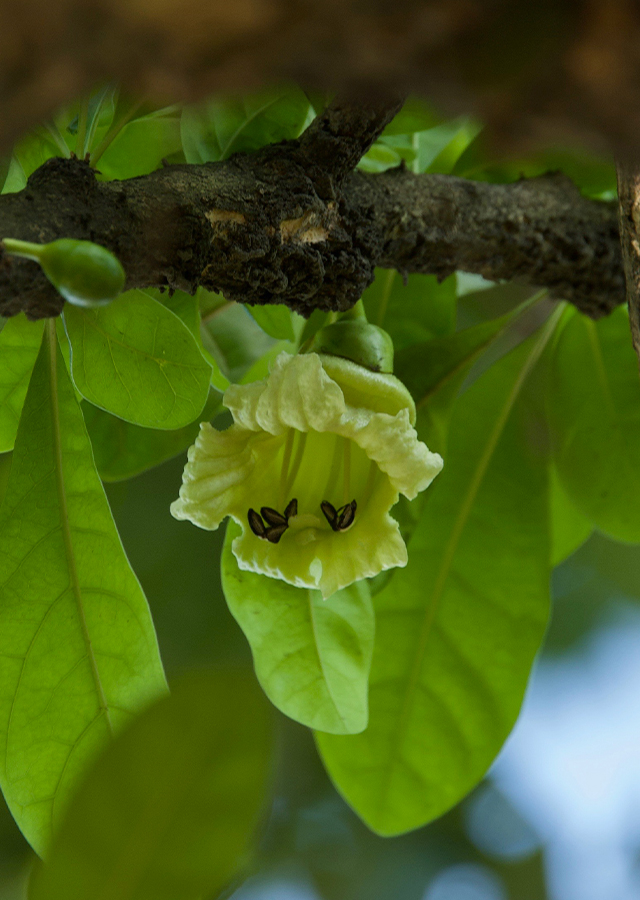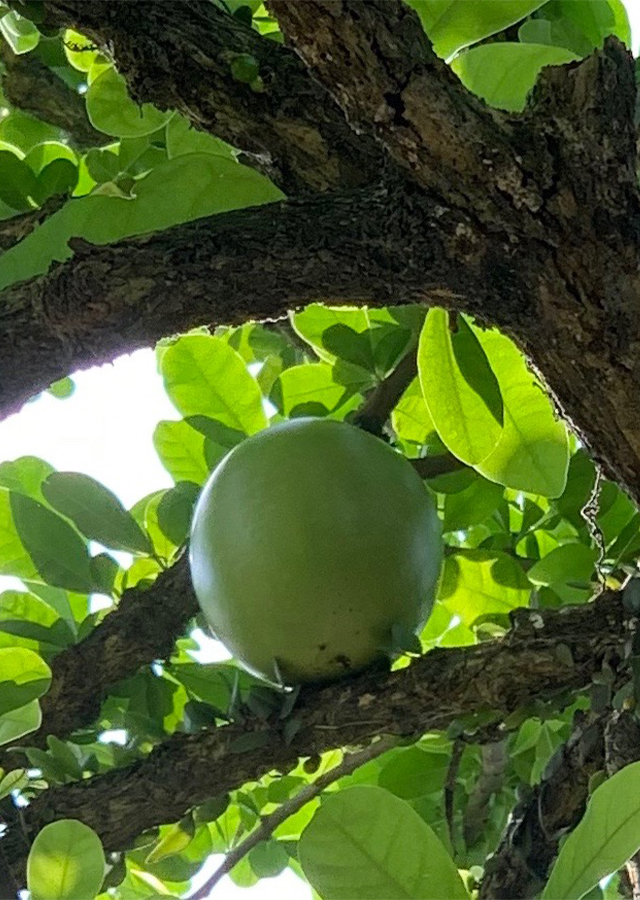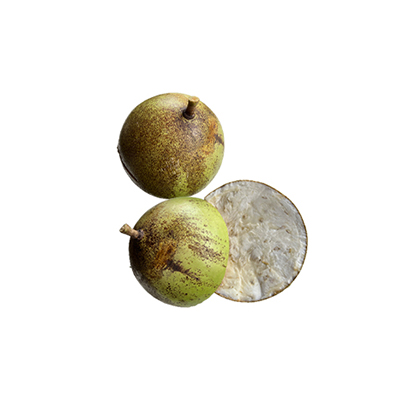Indian Bael
Aegle marmelos (L.) Correa
Rutaceae
Location in our garden
Orchard



Synonym
Crataeva marmelos L.
Feronia pellucida Roth
Crateva religiosa Ainslie
Habitus
Shrubs. A slow-growing deciduous shrub or tree that can reach an eventual height of 10 - 15 m, the bole, which is usually fluted at base, can be 50 cm in diameter
Part Used
Leaves
Bark
Fruit
Roots
Twigs
Growing Requirements
Full Sunshine
Drought Resistant
Habitat
Forest
Overview
Bael grows wild in dry forests in the Indian Peninsula, Sri Lanka, Pakistan and Bangladesh. It is an old cultivated tree in that region, particularly found in temple gardens in India. It has spread to Indo-China, South-East Asia (in particular Thailand, northern Malaysia, eastern Java and northern Luzon) and other parts of the tropics. Considered a sacred tree in the Hindu culture, the leaves are indispensable offerings to the Lord Shiva. The tree is commonly grown in the grounds of temples in countries such as India and Thailand, where the fruit is used to make a very refreshing drink for the monks.
Vernacular Names
Bilak (Malay), Bael (Philippines), Opesheet (Burmese), Bnau (Cambodia), Toum (Laos), Matum (Thai), Trái mam (Vietnamese).
Agroecology
The plant is a hardy, deciduous tree that can be grown in tropical and sub-tropic areas, being tolerant of harsh conditions, including extremes of temperature. It succeeds from sea level to an elevation of 1,200 metres where the mean annual temperature can range from -6 to 48 °C. Does best on rich, well-drained soils, but can tolerate poor soils and alkaline conditions. It also grows well in swampy, alkaline or stony soils having pH range from 5 to 8.
Morphology
- Trunks - 10-15 m tall, trunk 25-50 cm in diameter. Older branches spiny; spines single or paired, 1-2 cm long.
- Leaves - alternate, trifoliolate; petiole 2-4 cm long, lateral petiolules up to 3 mm, terminal up to 15 mm long; lateral leaflets ovate to elliptic, up to 7 cm × 4.2 cm, terminal obovate, up to 7.5 cm × 4.8 cm, densely minutely glandular-punctate.
- Flowers - axillary racemes, 4-5 cm long, clustered; sepals broadly deltoid, 1.5 mm long; petals oblong-obovate, 14 mm × 8 mm, greenish to white; stamens 35-45, white, filaments 4-7 mm long; ovary 8 mm × 4 mm, style very short.
- Fruits - subglobose berry, 5-12.5 cm diameter, often with a hard woody shell, of 8-16(-20) segments, with 6-10 seeds in a clear, sticky, edible pulp.
- Seeds - woolly-pubescent, enclosed in a sac of adhesive mucilage which solidifies on drying; testa white.
Cultivation
- Propagated by seeds - the plant is commonly grown from seed in nurseries and transplanted into the field. Seedlings show great variation in form, size, texture of rind, quantity and quality of pulp and number of seeds.
- By root sucker and budding onto seedling stocks.
Chemical Constituents
Alkaloids, cardiac glycosides, terpenoids, saponins, tannins, flavonoids, steroids, essential oils, sitosterol, marmelle oil, pectin, phenols, limonene, (E)-ß-ocimene, germacrene B.
Traditional Medicinal Uses
- The dried pulp is astringent. It reduces irritation in the digestive tract and is an excellent remedy in cases of diarrhoea and dysentery.
- A decoction of the astringent unripe fruit, combined with fennel and ginger, is prescribed in cases of haemorrhoids.
- A decoction of the unripe fruit is highly valued as an aphrodisiac and has gained a reputation of being the viagra of the plant world.
- The ripe fruit is also laxative and demulcent. It eases stomach pain and supports healthy function of the stomach.
- It has been surmised that the psoralen in the pulp increases tolerance of sunlight and aids in the maintaining of normal skin colour. It is employed in the treatment of leucoderma.
- For medicinal use, the young fruits, while still tender, are commonly sliced horizontally and sun-dried and sold in local markets.
- They are much exported to Malaysia and Europe. Because of the astringency, especially of the wild fruits, the unripe bael is most prized as a means of halting diarrhoea and dysentery, which are prevalent in India in the summer months.
- The leaves are astringent and are used in the treatment of peptic ulcers.
- A paste made from about 100 g of the leaves is mixed in a cup of water and administered orally once a day for 3 days in the treatment of diabetes.
- The dried root is used in the treatment of earache.
Part Used
Reference Sources
- Fern, Ken. Useful Tropical Plants. (2021). Aegle marmelos. https://tropical.theferns.info/viewtropical.php?id=Aegle+marmelos. 02-12-21.
- Plant Resources of South East Asia. Aegle marmelos. https://uses.plantnet-project.org/en/Aegle_marmelos_(PROSEA). 02-12-21.



